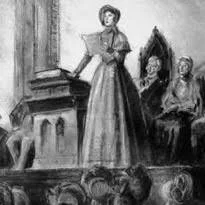Seneca Falls Convention, 1848
Q. You joined the Office of Government Information Services in May 2010, less than one year after it opened for business. Belated congratulations on your 10-year work anniversary! For those who might not know, what is your role at OGIS?
A. Thank you! My roles at OGIS have evolved over the years. My current role is two-fold: I lead the office’s review of agency FOIA policies, procedures and compliance, and I manage the FOIA Advisory Committee as its Designated Federal Officer. In the first role, I oversee a wide range of assessments, including those of FOIA issues that cut across agencies. In some cases, these two roles dovetail nicely as some of the Committee’s recommendations call on OGIS to assess various FOIA issues. Woven through both roles — and indeed through all of OGIS’s work — is serving as a listening ear and advocate for the FOIA process as the FOIA Ombudsman’s office. In OGIS’s early days — before the establishment of the compliance program and the Advisory Committee — I helped establish OGIS’s dispute resolution program and worked hundreds of cases helping requesters navigate the FOIA process.
Q. What would you say is different about the office now compared to 2010, aside from pandemic-related issues?
A. The biggest difference is that OGIS is now baked into the FOIA process in a way in which we were not in those early days. Before Congress passed the FOIA Improvement Act of 2016, our role was fairly limited to the post-appeal stage of the FOIA administrative process, and many agencies were unaware of our role and were not informing requesters of our services. Now, the statute requires agencies to alert requesters to our services at various stages throughout the FOIA process — this resulted in a huge increase in our caseload. Another difference is that we have earned the trust of agency FOIA professionals and requesters who know they can come to us for informal, confidential assistance with the FOIA process.
Q. What is the most frequent type of complaint that OGIS receives from requesters?
A. Delays have always made up a large portion of the inquiries we receive and that has increased during the pandemic. While some agencies seamlessly transitioned to a virtual work environment, others were unable to for a variety of reasons, including working primarily with classified records or using a FOIA tracking/processing system that operates in a classified system. Some pandemic-related delays are because agencies are unable to access paper records stored in Federal Records Centers which by and large have been closed during the public health emergency. We frequently hear from requesters who are confused about what to do next in the FOIA process: requesters may contact OGIS instead of filing an appeal, or contact OGIS and the FOIA Public Liaison and file an appeal, or any combination thereof. One of our roles is to clarify options to help requesters choose their next steps while not losing their administrative rights.
Q. Which complaints are the most difficult to resolve through mediation?
A. Two answers. The first are those cases which involve an exemption in which there is no discretion — Exemption 1 is a good example — and thus no room for negotiations. My second answer: those cases in which the requester (or, on occasion, the agency) is so convinced that they are correct that they cannot see beyond their own position. Dispute resolution works when parties are able to move beyond past grievances and be open to new possibilities.
Q. Can you tell us about an OGIS mediation success that stands out to you?
A. We facilitated a resolution between the Naval Research Laboratory (NRL) and National Public Radio (NPR) regarding a FOIA request for records about a World War II-era medical experiment that used human subjects. NRL released the records in full, but the release included photographs that were not of a high-enough resolution to be useful to NPR. NRL re-scanned the images and while better than the first set, the images were still not of high enough quality to publish in a companion story on NPR’s website. NRL closed the request and NPR contacted OGIS to see if the dispute could be resolved outside of the administrative appeal process. OGIS facilitated communication that included an exchange of information regarding scanner settings. NRL released a set of photos that met NPR’s needs and avoided an appeal. I am able to share this story with your readers because we got permission from both NRL and NPR, and included it in an OGIS Annual Report several years ago.
Q. When did you first encounter the FOIA?
A. I first used public records laws as a reporter in North Carolina in the 1990s. One early encounter I had with the federal FOIA occurred in the 1990s when, as a new Washington correspondent for a North Carolina newspaper, the FBI called to confirm my address because it had a huge box of documents responsive to my FOIA request — which had actually been filed not by my predecessor but by his predecessor. The records related to COINTELPRO, the FBI program aimed at surveilling and infiltrating domestic American political organizations. The records were fascinating and I was able to track down some of the subjects of the FBI’s surveillance who had been active with the Black Panther Party in North Carolina.
Q. Prior to joining OGIS, you worked for the Reporters Committee for Freedom of the Press, as well as the Sunshine in Government Initiative. Could you share one of your best experiences working with these media groups?
A. When I was at the Reporters Committee, I did an investigation on secret dockets in U.S. District Court in Washington, D.C., in which I found that in the five years prior, 469 cases had been kept completely off the public docket and prosecuted and tried in complete secrecy, with no public knowledge of the cases’ existence and no way for the public to challenge the secrecy. At the time of the project, federal appellate courts in two circuits had ruled that secret dockets were unconstitutional. Several months after the investigation, the U.S. Judicial Conference — the chief policy-making body for the federal court system — strongly recommended that all federal trial courts with electronic docketing systems clearly indicate to users that cases are sealed instead of displaying a notice reading “No such case.” Then-Chief Judge Thomas F. Hogan of the U.S. District Court in Washington, D.C., credited the Reporters Committee with uncovering the existence of the off-the-docket cases, and said the organization “did a good favor for us in discovering them.”
Q. We understand that you were involved with working to pass the OPEN Government Act of 2007. Aside from the creation of OGIS, what were the most important reforms in that legislation, and how do you think they’ve fared in application over the twelve years or so?
A. My involvement with passing the OPEN Government Act of 2007 during my time at the Sunshine in Government Initiative was somewhat indirect in that I was not involved with lobbying for the bill’s passage. I spent much of my time doing behind-the-scenes work such as putting together a database of stories made possible by FOIA to show that FOIA is important in all congressional districts, diving deep into data provided in Annual FOIA Reports, and researching state and international freedom of information ombudsman models. With regard to reforms in the 2007 FOIA legislation, one of the most important was the introduction of dispute resolution into the FOIA process. The OPEN Government Act of 2007 codified the FOIA Public Liaison role that President George W. Bush created in signing Executive Order 13392. Prior to 2007, the only remedy for a dissatisfied FOIA requester was to sue. Dispute resolution provides another route.
Q. Where do you think FOIA reform needs to head in the future?
A. I see a perfect storm brewing between the need for technology generally and artificial intelligence specifically, government funding for such technology, and what I hope is an increased interest in our nation’s records as a way to hold the government accountable and strengthen our democracy. Any future FOIA reforms are going to have to tackle those issues.
Q. As someone who has been a requester and now works within the federal government, what do you think is the most important thing that requesters and FOIA professionals could learn from one another?
A. Patience and perspective. It is really easy to jump to conclusions about why something is instead of asking questions that might shed light on the why. Entities like the FOIA Advisory Committee, which has members from both inside and outside and government; the American Society of Access Professionals (ASAP), a nonprofit professional organization that brings together requesters and agencies; and, I might add, OGIS, do a good job of bringing both sides together and fostering conversation, which leads to mutual understanding and respect.
Q. What is your proudest accomplishment(s)? Regret(s)?
A. No single accomplishment per se, but I am proud to have had two careers dedicated to public service, first as a journalist working in a profession enshrined in the First Amendment and second as a civil servant at the National Archives, an agency whose strategic goals include “Make Access Happen.”
Q. If you could travel back to any time and place for one day, what would you do and why?
A. This is a tough question, the answer to which changes daily. Today’s answer: the 1848 Seneca Falls convention on women’s rights (which was technically two days.) While many opposed Elizabeth Cady Stanton’s request to pass a resolution on the goal of women’s suffrage, Frederick Douglass spoke in favor by arguing that he could not, as a Black man, accept the right to vote if women could not also have that right. Douglass later diverged from that view when he supported the 15th Amendment, which banned discrimination based on race, but not on sex. This time in history interests me particularly now because of 2020’s celebration of the centennial of the 19th Amendment giving some but not all women the right to vote and our national reckoning with issues of racial equity.
Q. Name some of your favorite movies or books.
A. I’ve got a girl crush on author Ann Patchett who your readers might know for her latest novel, Dutch House, which was on several bestseller lists last year. Patchett’s 2001 novel, Bel Canto, based on the Japanese embassy hostage crisis in Lima, Peru, is my favorite of her eight novels: a gripping look at what it means to be human.

